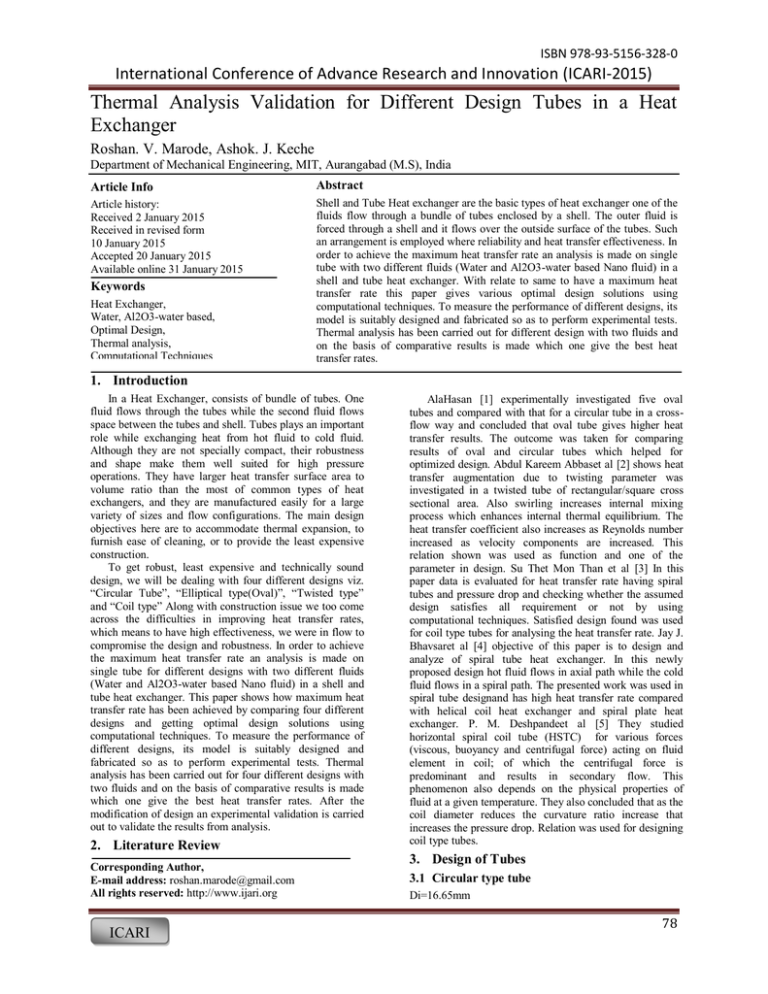
ISBN 978-93-5156-328-0
International Conference of Advance Research and Innovation (ICARI-2015)
Thermal Analysis Validation for Different Design Tubes in a Heat
Exchanger
Roshan. V. Marode, Ashok. J. Keche
Department of Mechanical Engineering, MIT, Aurangabad (M.S), India
Article Info
Abstract
Article history:
Received 2 January 2015
Received in revised form
10 January 2015
Accepted 20 January 2015
Available online 31 January 2015
Shell and Tube Heat exchanger are the basic types of heat exchanger one of the
fluids flow through a bundle of tubes enclosed by a shell. The outer fluid is
forced through a shell and it flows over the outside surface of the tubes. Such
an arrangement is employed where reliability and heat transfer effectiveness. In
order to achieve the maximum heat transfer rate an analysis is made on single
tube with two different fluids (Water and Al2O3-water based Nano fluid) in a
shell and tube heat exchanger. With relate to same to have a maximum heat
transfer rate this paper gives various optimal design solutions using
computational techniques. To measure the performance of different designs, its
model is suitably designed and fabricated so as to perform experimental tests.
Thermal analysis has been carried out for different design with two fluids and
on the basis of comparative results is made which one give the best heat
transfer rates.
Keywords
Heat Exchanger,
Water, Al2O3-water based,
Optimal Design,
Thermal analysis,
Computational Techniques
1. Introduction
In a Heat Exchanger, consists of bundle of tubes. One
fluid flows through the tubes while the second fluid flows
space between the tubes and shell. Tubes plays an important
role while exchanging heat from hot fluid to cold fluid.
Although they are not specially compact, their robustness
and shape make them well suited for high pressure
operations. They have larger heat transfer surface area to
volume ratio than the most of common types of heat
exchangers, and they are manufactured easily for a large
variety of sizes and flow configurations. The main design
objectives here are to accommodate thermal expansion, to
furnish ease of cleaning, or to provide the least expensive
construction.
To get robust, least expensive and technically sound
design, we will be dealing with four different designs viz.
“Circular Tube”, “Elliptical type(Oval)”, “Twisted type”
and “Coil type” Along with construction issue we too come
across the difficulties in improving heat transfer rates,
which means to have high effectiveness, we were in flow to
compromise the design and robustness. In order to achieve
the maximum heat transfer rate an analysis is made on
single tube for different designs with two different fluids
(Water and Al2O3-water based Nano fluid) in a shell and
tube heat exchanger. This paper shows how maximum heat
transfer rate has been achieved by comparing four different
designs and getting optimal design solutions using
computational techniques. To measure the performance of
different designs, its model is suitably designed and
fabricated so as to perform experimental tests. Thermal
analysis has been carried out for four different designs with
two fluids and on the basis of comparative results is made
which one give the best heat transfer rates. After the
modification of design an experimental validation is carried
out to validate the results from analysis.
2. Literature Review
Corresponding Author,
E-mail address: roshan.marode@gmail.com
All rights reserved: http://www.ijari.org
ICARI
AlaHasan [1] experimentally investigated five oval
tubes and compared with that for a circular tube in a crossflow way and concluded that oval tube gives higher heat
transfer results. The outcome was taken for comparing
results of oval and circular tubes which helped for
optimized design. Abdul Kareem Abbaset al [2] shows heat
transfer augmentation due to twisting parameter was
investigated in a twisted tube of rectangular/square cross
sectional area. Also swirling increases internal mixing
process which enhances internal thermal equilibrium. The
heat transfer coefficient also increases as Reynolds number
increased as velocity components are increased. This
relation shown was used as function and one of the
parameter in design. Su Thet Mon Than et al [3] In this
paper data is evaluated for heat transfer rate having spiral
tubes and pressure drop and checking whether the assumed
design satisfies all requirement or not by using
computational techniques. Satisfied design found was used
for coil type tubes for analysing the heat transfer rate. Jay J.
Bhavsaret al [4] objective of this paper is to design and
analyze of spiral tube heat exchanger. In this newly
proposed design hot fluid flows in axial path while the cold
fluid flows in a spiral path. The presented work was used in
spiral tube designand has high heat transfer rate compared
with helical coil heat exchanger and spiral plate heat
exchanger. P. M. Deshpandeet al [5] They studied
horizontal spiral coil tube (HSTC) for various forces
(viscous, buoyancy and centrifugal force) acting on fluid
element in coil; of which the centrifugal force is
predominant and results in secondary flow. This
phenomenon also depends on the physical properties of
fluid at a given temperature. They also concluded that as the
coil diameter reduces the curvature ratio increase that
increases the pressure drop. Relation was used for designing
coil type tubes.
3. Design of Tubes
3.1 Circular type tube
Di=16.65mm
78
ISBN 978-93-5156-328-0
International Conference of Advance Research and Innovation (ICARI-2015)
Do=19.05mm
Thickness=t=18BWG
Length= 1000mm
3.3 Twisted Type Tube
Length (L) = 1000mm
Thickness (t) = 1.2mm
Breadth of rectangular tube (b) = 22 mm
Depth of rectangular tube (d) = 8mm
No. of twists (Nt) = 05 (Each at 200mm)
Source:
1) Design of Heat Exchange equipment.
2) Design shell and tube heat exchanger [Rajiv Mukherjee
Engineers India Ltd.]
3) Handbook of TEMA.
3.2 Elliptical Type Tube (Oval)
Axis Ratio = Ra=3
Major Axis = 2a=22 mm
Minor Axis =2b=8mm
Source:
1)
2)
Thermal-Hydraulic performance of oval tubes in a
cross-flow air- ALA-HASAN
Structural and Thermal Analysis of Heat Exchanger
with Tubes of Elliptical Shape -Nawras H.
MostafaQusay R. Al-Hagag
Source:
1)
2)
Twisted Tube Heat Exchanger Technology-R. Donald
Morgan
Twist parameter influence on heat transfer coefficient
augmentation for a square twisted tube- A. Kareem
3.4 Coil Type Tube
Diameter (D0) =3/4”=19.05mm
Length (L) = 1000mm
Number of turns (n) = 6
Thickness (t) = 1.2mm
Effective coil diameter (D) = 52mm
Pitch (p) for helical it is taken as 1.5D0 ≡ 30mm
To know the unknown parameter, D (Coil Diameter)
Equation is given by,
L =N
ICARI
79
ISBN 978-93-5156-328-0
International Conference of Advance Research and Innovation (ICARI-2015)
S
r.
N
o
Mass
flow
rate(Kg/
sec)
1
2
0.14
0.12
Temperatures at different points of tube
(⁰C)
T1(
At
T2(
star At
T4
t
250
T3(At (At
T5(At
0m
mm 500m 750m 1000m
m)
)
m)
m)
m)
67
66.5 65.5
65
64
67
66.5 66.5
65
64
3
0.05
66.5
1000 =6
=
=
=
Therefore,
R = 26.13mm
D ≡ 52 mm
Source:
1) ASME German AD-Merkblatt
2) European pressure equipment directive (PED)
Designing a helical-coil heat exchangers- K. Ramchandra
4.1.2
4. Experimental Work
We achieved temperature range by placing thermocouple at
250 mm apart for four design tubes.
T1 = Temperature at inlet of tube.
T2=Temperature at a distance of 250mm from inlet.
T3= Temperature at a distance of 500mm from inlet.
T4=Temperature at a distance of 750mm from inlet.
T5=Temperature at outlet of tube.
Mass
flow
rate(Kg/
sec)
1
2
3
0.14
0.12
0.05
64.5
63.5
Temperatures at different points of
tube (⁰C)
T1(
At
T2(
star At
T4
t
250
T3(At (At
T5(At
0m
mm 500m 750m 1000m
m)
)
m)
m)
m)
67.5 65
64.5
64
63.5
63
62.5 62
61
59.5
63
62
62
61.5
60
For Twisted type
S
r.
N
o
Mass
flow
rate(Kg/
sec)
1
2
3
0.14
0.12
0.05
4.1.4
65
For Elliptical type
S
r.
N
o
4.1.3
66
Temperatures at different points of
tube (⁰C)
T1(
At
T2(
star At
T4
t
250
T3(At (At
T5(At
0m
mm 500m 750m 1000m
m)
)
m)
m)
m)
64
62
60
58.5
56.5
56
54
53
52
51
58
57
56
54
53
For Coil type
S
r.
N
o
Mass
flow
rate(Kg/
sec)
1
2
3
0.14
0.12
0.05
Temperatures at different points of
tube (⁰C)
T1(
At
T2(
star At
T4
t
250
T3(At (At
T5(At
0m
mm 500m 750m 1000m
m)
)
m)
m)
m)
68
68
67
65
63
65.5 65
64.5
62
58
61
60
60.5
58
56.5
5. Calculations for heat transfer coefficient
5.1 For case I (water-water)
4.1 For (Water –Water as a fluid)
4.1.1
For circular type
ICARI
Fluid properties for water are:
μ = 0.467xNs/
ρ = 1000 kg/
Cp = 4.18xJ/kg⁰k
kw = 0.625w/m⁰k
For Circular type:
Ac/s = (π[d02-di2]
80
ISBN 978-93-5156-328-0
International Conference of Advance Research and Innovation (ICARI-2015)
= (π[0.019052-0.016652]
= 6.73x10-5m2
As Reynolds number for circular tube is given by,
Re=ρvd/μ
(1)
to find V,
We know continuity equation,
Q=AxV
As density = mass/volume (ρ=m/vol.)
Therefore, m= A x ρ x V
(1a)
For mass flow rate =m=0.14kg/sec
0.14 = Vx1000x6.73x10-5
V= = 2.08m/s
V= 2.08 m/s
So,
Re = 74158.45
From Reynolds number, flow is turbulent.(Re>2000)
Sr.
Type of
V
Re
No.
Design
Circular
2.08
74158.4
1
Elliptical
1.7
23516.1
2
Twisted
2.11
19952.4
3
4
Coil
2.09
23032.5
5.2 Calculated outcome of Case-II (AL2O3-Water
as a Nano fluid)
Fluid properties for Al2O3- water (0.1 % concentration) are:
μ=0.35
cp=3.5xNs/
ρ=1022
kg/
Cp=3.1xJ/kg⁰k
k=0.72w/m⁰k,
Prandtl number obtained from calculation is common for all
type of deign as fluid properties are common, viz 1.5
Sr. Type of
V
Re
H
Q
є
No. Design
1
2
3
4
Circular 2.06 100153.08 11399.20
20.63 0.38
Elliptical 1.63 30761.90
Twisted 2.07 26563.12
Coil
2.04 30617.95
20.16 0.30
23.18 0.60
24.01 0.40
11427.08
14864.54
14307.87
Correlation used for turbulent flow is;
Nu= = CReaPrb-m
(1b)
Where C = 0.021 for gases,
= 0.023 for non-viscous liquids,
= 0.027 for viscous liquids
Nu= = CReaPrb-m
= 0.023xRe0.8Pr (1/3) x1
= 0.023x(74158.45)0.8x(Pr)(1/3)
(1c)
Pr =μCp/k ………. (Depend only on fluid properties)
= 3.12
Equation 1c, → = 0.023 x (74158.45)0.8 x (3.12) (1/3)
ȟ
= 9932.08 w/m2⁰K
Likewise, calculated heat transfer rate for other three tubes
are:
Pr
h
∆P
Q
є
3.12
3.12
3.12
3.12
9932.08
10213.7
13100.6
12625.1
31.18
54.91
29.3
36.72
19.6
19.22
19.83
21.91
0.35
0.24
0.53
0.34
120000
100000
80000
Circular
Elliptical
60000
Twisted
40000
Coil
20000
0
V
Re
Pr
h
Q
є
6. Thermal Analysis of Tubes with two
different media
6.1 CFD-Results of Case-I
Mass flow rate: 0.14 kg/s
Temperature Contours
1. For Circular tube
ICARI
81
ISBN 978-93-5156-328-0
International Conference of Advance Research and Innovation (ICARI-2015)
2. Elliptical Tube :
3. Twisted Tube :
4. Coil Tube: (For three planes)
i. Temperature Contours
ii. h-Contours for inner wall
6.2. CFD-Results of Case-II (Al2O3 as a Nano fluid):
We have focused only on twisted type tube as in above sequence of calculations we are getting high heat transfer rate
and high effectiveness by calculation.
ICARI
82
ISBN 978-93-5156-328-0
International Conference of Advance Research and Innovation (ICARI-2015)
This study shows the design and thermal analysis of
different tubes. Experimentally, same designs are made and
results are evaluated. With relate to same design tubes are
thermally analysed in ANSYS software and compared both
the results. After comparing the result for both water-water
(Case-I) and water-Al2O3 (Case-II) for four different
tubes we are in conclusion that twisted type of tube is giving
high heat transfer coefficient as compared to other i.e 1.14
more. Along with effectiveness, twisted tube is at higher
side by 1.17.So according to my research one should go for
twisted tube.
However, a good understanding of the underlying
principles of exchanger design is needed to use this software
effectively. The possibility to increase in these
characteristics using the latest technology and various
methods has raised application range of these designs.
Modified design tubes are having great applications due to
their large heat transfer area and high heat transfer
coefficients. They are used in many industrial processes
like waste water treatment, refrigeration, wine and beer
making, petroleum refining
References
[5]
In above colourful diagram, if we compare d the twisted
tube temperature contours with water as base fluid, an CFD
analyst may observe that for 4th and 5th plane we are getting
blue colour contours as compared to case 1, which directly
shows the temperature gradient in above case is high along
with effectiveness.
7. Conclusion
K. Sriharsha, V. R. Mamilla, Strength Analysis of
Tube to Tube Sheet Joint in Shell and Tube Heat
Exchanger, IJSETR, 1(4), 2012
[2] Haran, R. Reddy, Thermal Analysis of Shell and Tube
Heat Ex-Changer Using C and Ansys, (IJCTT), 4(7),
2013
[3] Effectively Design Shell-and-Tube Heat Exchangers,
Chemical Engineering Progress, 1998
[4] Paresh Patel, Amiteshpaul, Thermal Analysis Of
Tubular Heat Exchanger By Using Ansys, (IJERT),
1(8), 2012
[1]
ICARI
[6]
[7]
[8]
[9]
[10]
Vikil D. Malwe, M. B. Mawale, Thermal Analysis of
Heat Transferring Components in the Power Plant - A
Review, (IJERT), 2(1), 2013
TEMA, Standards of the Tubular Exchanger
Manufacturers’ Association, New York 7th ed., 1988
D. Butterworth, A. R. Guy, J. J. Welkey, Design and
Application of Twisted Tube Heat Exchangers
W. M. Small, R. K. Young, Heat Transfer Engineering,
1, 1979
P. Patel, Amiteshpaul, Thermal Analysis Of Tubular
Heat Exchanger By Using Ansys, Proc. IJERT, 1(8),
2012
C. C. Gentry, Chem. Engng. Progress, 86(7), 48-57
83





